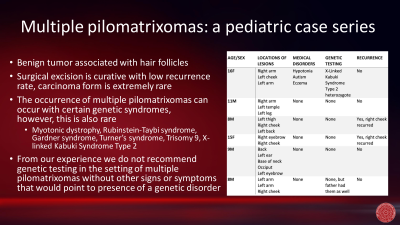Pediatrics
Category: Quickshot Oral Session 26
Quickshot Oral : Quickshot Oral Session 26
MULTIPLE PILOMATRIXOMAS: A PEDIATRIC CASE SERIES
Tuesday, February 14, 2023
7:00am - 8:00am East Coast USA Time

- CC
CAITLIN CROSIER, MD
RESIDENT
PRISMA HEALTH - UPSTATE, United States - CC
CAITLIN CROSIER, MD
RESIDENT
PRISMA HEALTH - UPSTATE, United States
Presenter(s)
Principal Contact(s)
Objectives: A pilomatrixoma is a benign tumor associated with hair follicles, usually on the head or neck, most common in children in a 3:1 female-to-male ratio. They present as firm, mobile, asymmetric nodular subcutaneous lesions that are asymptomatic otherwise. Surgical excision is curative with low recurrence rate. The occurrence of multiple pilomatrixomas is more common with other syndromes including myotonic dystrophy 1 (MD1), Familial Adenomatous Polyposis, Rubinstein-Taybi syndrome, Gardner syndrome, sarcoidosis, Turner’s syndrome, Trisomy 9, X-linked Kabuki Syndrome Type 2. Many of these syndromes also manifest other skin abnormalities. Mutation of the beta-catenin (CTNNB1) gene, a gene responsible for cell-to-cell adhesion and gene transcription, has been noted in cells only within the lesion itself.
There have been six documented cases of multiple pilomatrixoma in pediatric patients at Prisma Health Upstate since 2001.
1.) A 16-year-old female with autism, eczema and hypotonia presented with 4 pilomatrixomas beginning at age 6, of the left cheek, left and right arm, and right shoulder. Genetic testing revealed heterozygous duplication of the X-linked Kabuki Syndrome Type 2 gene.
2.) An 11-year-old male presented with 3 pilomatrixomas of the right arm, left temple, and left leg. He was referred but did not undergo genetic testing.
3.) An 8-year-old male with a history of right cheek and left neck pilomatrixoma presented with new left thigh and recurrent right cheek lesions and again later with a left back lesion, all pilomatrixomas. Genetic testing was performed only on APC and MUTYH and was negative.
4.) A 15-year-old female presented with right eyebrow and right cheek pilomatrixomas. She had recurrence of the right cheek lesion which was found to be invading the salivary gland. MD1 genetic testing was negative.
5.) A 9-year-old male with a history of bicuspid aortic valve presented with back, left ear, neck, occiput, left eyebrow pilomatrixomas. He was referred but did not undergo genetic testing.
6.) A 5-year-old male presented with a pilomatrixoma of the left arm, then three years later with left arm and right cheek pilomatrixomas. His father also had a pilomatrixoma. He was referred but did not undergo genetic testing
To our knowledge this collection is the largest case series of children with multiple pilomatrixomas at a single institution. The historical association with genetic disorders leads us to recommend excision of suspicious lesions for confirmation and referral for genetic testing when multiple pilomatrixomas are confirmed, and monitoring for future lesions throughout the patient's lifetime.
Methods:
Results:
Conclusion:
There have been six documented cases of multiple pilomatrixoma in pediatric patients at Prisma Health Upstate since 2001.
1.) A 16-year-old female with autism, eczema and hypotonia presented with 4 pilomatrixomas beginning at age 6, of the left cheek, left and right arm, and right shoulder. Genetic testing revealed heterozygous duplication of the X-linked Kabuki Syndrome Type 2 gene.
2.) An 11-year-old male presented with 3 pilomatrixomas of the right arm, left temple, and left leg. He was referred but did not undergo genetic testing.
3.) An 8-year-old male with a history of right cheek and left neck pilomatrixoma presented with new left thigh and recurrent right cheek lesions and again later with a left back lesion, all pilomatrixomas. Genetic testing was performed only on APC and MUTYH and was negative.
4.) A 15-year-old female presented with right eyebrow and right cheek pilomatrixomas. She had recurrence of the right cheek lesion which was found to be invading the salivary gland. MD1 genetic testing was negative.
5.) A 9-year-old male with a history of bicuspid aortic valve presented with back, left ear, neck, occiput, left eyebrow pilomatrixomas. He was referred but did not undergo genetic testing.
6.) A 5-year-old male presented with a pilomatrixoma of the left arm, then three years later with left arm and right cheek pilomatrixomas. His father also had a pilomatrixoma. He was referred but did not undergo genetic testing
To our knowledge this collection is the largest case series of children with multiple pilomatrixomas at a single institution. The historical association with genetic disorders leads us to recommend excision of suspicious lesions for confirmation and referral for genetic testing when multiple pilomatrixomas are confirmed, and monitoring for future lesions throughout the patient's lifetime.
Methods:
Results:
Conclusion:

